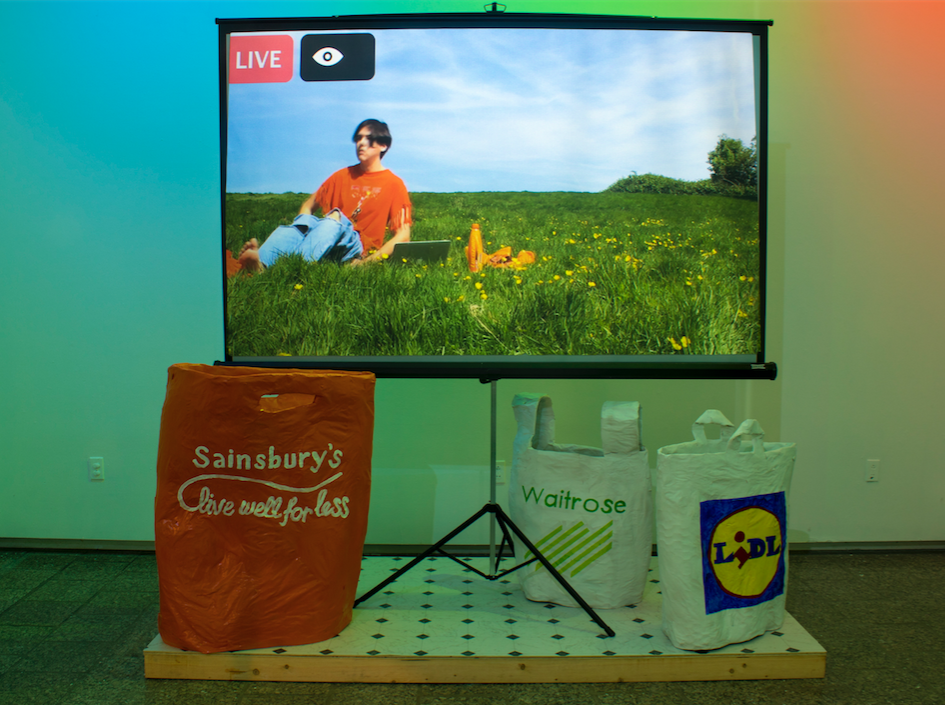Roski student addressed tech dystopia in solo exhibit
“YOU are your own microcelebrity.” “YOUR digital content is your mundane labor. It is not your leisure. Someone is turning a profit.” These epiphanies came from the mind and work of Jeremy Reynoso, a senior studying at the USC Roski School of Art and Design.
Reynoso’s first solo exhibition was on display at Helen Lindhurst Fine Arts Gallery in the Roski School of Art and Design until last Thursday. The show was confrontational, electric and controversial. Nothing was shy, including the aforementioned artist statement, stacks of which lay within one of the installations. At the top of the tree of life there isn’t love: there is lulz carries a message intended for mass absorption, but it was particularly impactful within the piece.
Video compilations, sculpture, audio tracks and digital projections came together to deliver a clear message both psychologically and playfully. As viewers entered the show, they were greeted with what Reynoso described as “a culmination of everything I’ve been thinking about for the past year or so.”
As for the title of the show: “The origin of the quote is dark … it is reminiscent of how we are living our lives through our phones, in a mediated space,” Reynoso said, adding, “We are living in an economy of attention as opposed to a real, social world.”
In front of the entryway was “A Return to Gameday.” The piece was decorated with USC folding chairs and coolers, and it sat behind “Hypebeast Overlord” statues, two ghostfaced characters adorned in garments patched with what seems to be every Greek letter the artist was able to acquire. Mounted on the cardinal coolers was a screen with a video of USC gameday-related footage and two ghost-faced figures dancing in an anything-but-subtle manner. Though the style of the video and the characters’ actions within it were seemingly playful, there was a darker message at play that was inevitably controversial.
Reynoso described the piece as, “an exploration of gameday but also the larger culture it represents.” The piece was an “explicit cry for attention,” meant to address the traditionally exclusive “singular narrative” being sold to everyone. He noted that it was not an attack on anyone specific. Rather, it was a critique of wider establishments that exclude non-binary narratives.
A video projection and sculpture combination entitled “Ethical Consumer” alluded to the waves that seem to superficially mark and define Reynoso’s generation. A re-recorded, auto-tuned and offbeat rendition of “Closer” by The Chainsmokers played in the background as Reynoso appeared dancing and laying somberly in a field of grass.
To the very right of the exhibit was “Manifesto for a Social Digital Task Force,” the face of the gadget’s screen projected on a hanging sheet. On the dark screen read “My Media Library,” an invitation into someone’s video folder. Reynoso said he felt most connected to this piece because of its unwavering relevance.
He described himself as “helplessly addicted” to social media. As for the future of social media, he believes that “people are starting to realize it is making them unhappy.”
Reynoso said he wants to create art that is conscious of non-binary narratives, the larger implications of day-to-day habits and the refusal to accept the status quo. On-screen and within his work, Reynoso appeared as a fictional character, or, in his own terms, “a virtual molecule.” But unlike the masses who indulge in tech and social media, Reynoso is aware of its power and its widespread, deeply affecting nature. His critiques were not attacks; rather, they addressed the heteronormativity, racism and sexism that he believes have been rooted in and perpetuated by many institutions.
Reynoso is not interested in making art that will please everyone, making him more susceptible to criticism. Reynoso is clearly not taking small steps; he is already addressing existential concepts without fear or hesitation, inviting controversy and advocating for social awareness and equality in an artistic approach intrinsically linked to and thus accessible for the modern generation.

